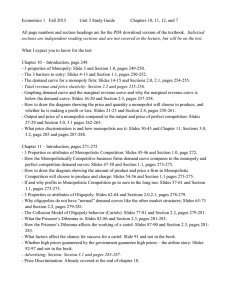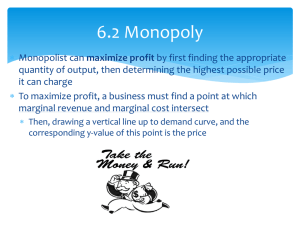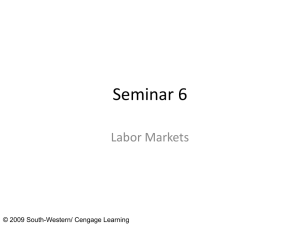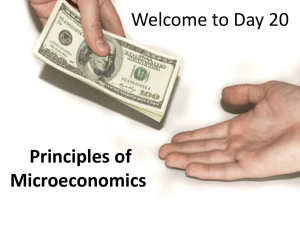Sections 1.0,1.1, pages 297-301.
advertisement
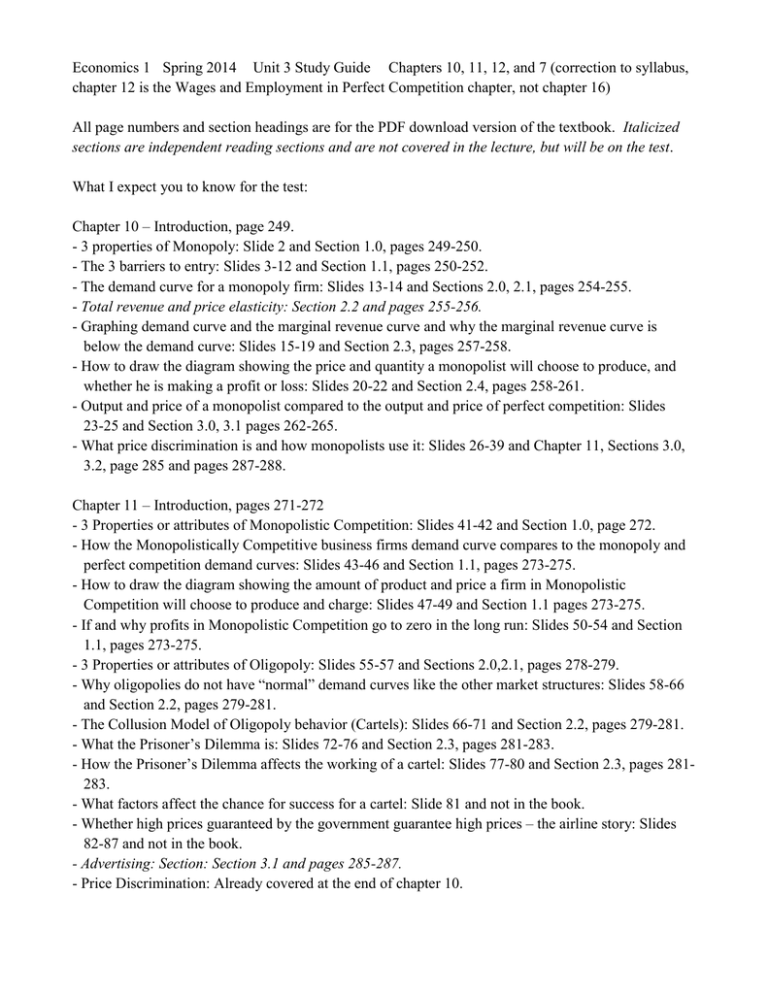
Economics 1 Spring 2014 Unit 3 Study Guide Chapters 10, 11, 12, and 7 (correction to syllabus, chapter 12 is the Wages and Employment in Perfect Competition chapter, not chapter 16) All page numbers and section headings are for the PDF download version of the textbook. Italicized sections are independent reading sections and are not covered in the lecture, but will be on the test. What I expect you to know for the test: Chapter 10 – Introduction, page 249. - 3 properties of Monopoly: Slide 2 and Section 1.0, pages 249-250. - The 3 barriers to entry: Slides 3-12 and Section 1.1, pages 250-252. - The demand curve for a monopoly firm: Slides 13-14 and Sections 2.0, 2.1, pages 254-255. - Total revenue and price elasticity: Section 2.2 and pages 255-256. - Graphing demand curve and the marginal revenue curve and why the marginal revenue curve is below the demand curve: Slides 15-19 and Section 2.3, pages 257-258. - How to draw the diagram showing the price and quantity a monopolist will choose to produce, and whether he is making a profit or loss: Slides 20-22 and Section 2.4, pages 258-261. - Output and price of a monopolist compared to the output and price of perfect competition: Slides 23-25 and Section 3.0, 3.1 pages 262-265. - What price discrimination is and how monopolists use it: Slides 26-39 and Chapter 11, Sections 3.0, 3.2, page 285 and pages 287-288. Chapter 11 – Introduction, pages 271-272 - 3 Properties or attributes of Monopolistic Competition: Slides 41-42 and Section 1.0, page 272. - How the Monopolistically Competitive business firms demand curve compares to the monopoly and perfect competition demand curves: Slides 43-46 and Section 1.1, pages 273-275. - How to draw the diagram showing the amount of product and price a firm in Monopolistic Competition will choose to produce and charge: Slides 47-49 and Section 1.1 pages 273-275. - If and why profits in Monopolistic Competition go to zero in the long run: Slides 50-54 and Section 1.1, pages 273-275. - 3 Properties or attributes of Oligopoly: Slides 55-57 and Sections 2.0,2.1, pages 278-279. - Why oligopolies do not have “normal” demand curves like the other market structures: Slides 58-66 and Section 2.2, pages 279-281. - The Collusion Model of Oligopoly behavior (Cartels): Slides 66-71 and Section 2.2, pages 279-281. - What the Prisoner’s Dilemma is: Slides 72-76 and Section 2.3, pages 281-283. - How the Prisoner’s Dilemma affects the working of a cartel: Slides 77-80 and Section 2.3, pages 281283. - What factors affect the chance for success for a cartel: Slide 81 and not in the book. - Whether high prices guaranteed by the government guarantee high prices – the airline story: Slides 82-87 and not in the book. - Advertising: Section: Section 3.1 and pages 285-287. - Price Discrimination: Already covered at the end of chapter 10. Chapter 12 – Introduction, pages 295-297 - What Marginal Revenue Product and Marginal Factor Cost are: Slides 88-93 and Sections 1.0,1.1, pages 297-301. - That a business will buy factors up until MRP = MFC: Slides 94-95 and Sections 1.0,1.1, pages 297301. - That a business’s MRP curve is their demand curve for labor and other factors: Slides 96-97 and Sections 1.0,1.1, pages 297-301. - How equilibrium wages are determined: Slides 98-100 and Sections 3.0,3.1, pages 311-314. - How things that move the MRP curve, like technology, can be expected to change wages: Slides 101102 and Sections 3.0,3.1, pages 311-314. - The Marginal Productivity Theory predicts factors, including labor, will be paid their Marginal Revenue, as long as there is competition: Slides 103-117 and Sections 3.0,3.1, pages 311-314. - Competitive Labor Markets and the Minimum Wage: Slides 118-120 and Section 3.2, pages 314-318. - Technological progress, income inequality, and men and women: Slides 319-330 and Section 3.2, pages 314-318. Chapter 7 – Introduction, page 163 - The Definition of Utility: Slides 132-134 and Section 1.0, page 164. - Marginal Utility, the Law of Diminishing Marginal Utility, and Total Utility: Slides 135-138 and Sections 1.1,1.2, pages 164-165. - Does Money have diminishing marginal utility and what that implies for our insurance and gambling purchasing decisions: Slides 139-142 and not in the book. - Consumer equilibrium occurs when the consumer has bought a bundle of goods so that the marginal utility of the last dollar spent on each good is the same: Slides 143-161 and Section 1.3, pages 166168. - Shopping can be thought of as comparing how much you like the good to its price, or in math terms: MUA/PA=MUB/PB: Slides 143-161 and Section 1.3, pages 167-168. - Deriving the Demand Curve: Slides 162-169 and Sections 2.0,2.1 and pages 170-172. - From individual to market demand: Section 2.2 and pages 172-173. Sections not covered and not on the test. Chapter 10: Section 3.2 Chapter 11: Sections 1.2, 3.1 Chapter 12: Sections 1.2, 2.0, 2.1, 2.2, 2.3 Chapter 7: Sections 2.3, 2.4, 3.0, 3.1, 3.2, 3.3, 3.4, 3.5 Colleges are full of knowledge: the freshmen always bring a little in and the graduates never take any out, so it builds up. - A. Lawrence Lowell
